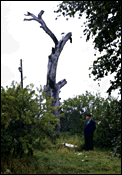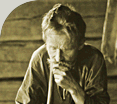
|
 |
|
 The Jamanen granary is the only building in Uhtua which can
be confidently connected with Lönnrot's name. On his sixth
field trip, (1835), Lönnrot had the owner of the granary, Varahvontta
Jamanen, sing poems for him, and on his seventh trip (1836) he stayed
with Jamanen for three weeks, as did his travelling companion J.F.
Cajan.
The Jamanen granary is the only building in Uhtua which can
be confidently connected with Lönnrot's name. On his sixth
field trip, (1835), Lönnrot had the owner of the granary, Varahvontta
Jamanen, sing poems for him, and on his seventh trip (1836) he stayed
with Jamanen for three weeks, as did his travelling companion J.F.
Cajan.
After the War, the granary was converted into a residence. It has
been preserved for future generations thanks to Niina Vatanen, who
refused to move out of the building when officials wanted to tear
it down.
|
|
 Lönnrot's
pine was once located at the mouth of the Uhtua River on the
shore of Lake Kuittijärvi. Tradition has it that Lönnrot
had bards sing at this tree, but this cannot be the case, since
his visits to Uhtua took place in April and November. In the 1950s,
a couple felled the dead, petrified pine and had cut much of it
up into firewood before anyone noticed what was happening. The top
portion of the tree was planted to the west of the old House of
Culture. When the Stalin cult was eradicated, the tree was moved
to its present location on the other side of the House of Culture,
where it rests on what was the base of Stalin's statue. Lönnrot's
pine was once located at the mouth of the Uhtua River on the
shore of Lake Kuittijärvi. Tradition has it that Lönnrot
had bards sing at this tree, but this cannot be the case, since
his visits to Uhtua took place in April and November. In the 1950s,
a couple felled the dead, petrified pine and had cut much of it
up into firewood before anyone noticed what was happening. The top
portion of the tree was planted to the west of the old House of
Culture. When the Stalin cult was eradicated, the tree was moved
to its present location on the other side of the House of Culture,
where it rests on what was the base of Stalin's statue.
|
 The
Siivakko house is one of the oldest in Uhtua. Many attempts were
made to have this house torn down, but it was saved by its inhabitant,
Olga Leontjeva, now deceased. The
Siivakko house is one of the oldest in Uhtua. Many attempts were
made to have this house torn down, but it was saved by its inhabitant,
Olga Leontjeva, now deceased. |
|
Uhtua
Poetry collecting in Uhtua
What to see
Panorama
Audio sample
|
|

 The
Siivakko house is one of the oldest in Uhtua. Many attempts were
made to have this house torn down, but it was saved by its inhabitant,
Olga Leontjeva, now deceased.
The
Siivakko house is one of the oldest in Uhtua. Many attempts were
made to have this house torn down, but it was saved by its inhabitant,
Olga Leontjeva, now deceased. The Jamanen granary is the only building in Uhtua which can
be confidently connected with Lönnrot's name. On his sixth
field trip, (1835), Lönnrot had the owner of the granary, Varahvontta
Jamanen, sing poems for him, and on his seventh trip (1836) he stayed
with Jamanen for three weeks, as did his travelling companion J.F.
Cajan.
The Jamanen granary is the only building in Uhtua which can
be confidently connected with Lönnrot's name. On his sixth
field trip, (1835), Lönnrot had the owner of the granary, Varahvontta
Jamanen, sing poems for him, and on his seventh trip (1836) he stayed
with Jamanen for three weeks, as did his travelling companion J.F.
Cajan. Lönnrot's
pine was once located at the mouth of the Uhtua River on the
shore of Lake Kuittijärvi. Tradition has it that Lönnrot
had bards sing at this tree, but this cannot be the case, since
his visits to Uhtua took place in April and November. In the 1950s,
a couple felled the dead, petrified pine and had cut much of it
up into firewood before anyone noticed what was happening. The top
portion of the tree was planted to the west of the old House of
Culture. When the Stalin cult was eradicated, the tree was moved
to its present location on the other side of the House of Culture,
where it rests on what was the base of Stalin's statue.
Lönnrot's
pine was once located at the mouth of the Uhtua River on the
shore of Lake Kuittijärvi. Tradition has it that Lönnrot
had bards sing at this tree, but this cannot be the case, since
his visits to Uhtua took place in April and November. In the 1950s,
a couple felled the dead, petrified pine and had cut much of it
up into firewood before anyone noticed what was happening. The top
portion of the tree was planted to the west of the old House of
Culture. When the Stalin cult was eradicated, the tree was moved
to its present location on the other side of the House of Culture,
where it rests on what was the base of Stalin's statue.